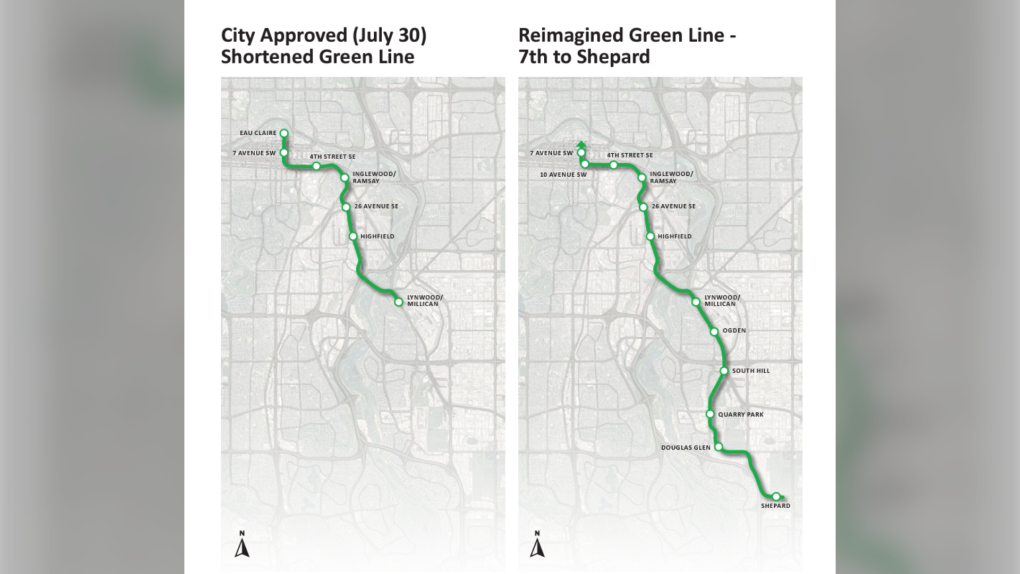Alberta's new CTrain Green Line plan includes elevated downtown tracks, more stops
The province has released a “reimagined” plan for the Green Line CTrain track that it says is longer and less expensive than what the City of Calgary had planned.
The province contracted AECOM to identify and assess an alternative that avoids tunnelling in downtown Calgary. Details of that new route were released on Friday.
Based on the AECOM report, the province is proposing a new Green Line alignment from Seventh Avenue to Shepard.
“This new Green Line route saves more than a billion dollars in tunnelling costs," said Devin Dreeshen, minister of transportation and economic corridors, in a statement.
"This alignment adds five more stops, will be 76 per cent longer and will serve 60 per cent more Calgarians – all within the same budget."
Alberta’s government says this route more closely aligns with the initial provincially and federally approved business case from June 2021.
 Side-by-side maps show the City of Calgary approved Green Line route and the reimagined Green Line plan, proposed by the Government of Alberta in December 2024. (Government of Alberta)
Side-by-side maps show the City of Calgary approved Green Line route and the reimagined Green Line plan, proposed by the Government of Alberta in December 2024. (Government of Alberta)
“The ball is now in Calgary City Council's court to approve this alignment and to finally start construction on the Green Line in the new year,” said Dreeshen.
Calgary Mayor Jyoti Gondek, along with councillors Peter Demong and Andre Chabot, met with Premier Danielle Smith and Dreeshen on Friday morning to receive a briefing on the province’s proposal, according to a statement from the mayor’s office.
“While the briefing provided an outline of the provincial proposal for the project, Calgary council has not been provided with the report submitted to the province by AECOM outlining the proposed plan, nor the related financials,” the statement reads.
The mayor and councillors are scheduled to hold a media availability on Monday to provide further details about the proposal.
The report suggests the downtown section of the Green Line should be elevated and shorter, cutting out Eau Claire and instead ending at Seventh Avenue to integrate with the existing Red and Blue Lines.
The province says that could save more than $1 billion compared to the city’s longer downtown route involving tunnels.
“Developed transit systems are essential to getting people to work, home, and keeping Canadians connected throughout their communities,” reads a statement from the office of Sean Fraser, Canada’s minister of housing, infrastructure and communities.
“We look forward to the City of Calgary’s input on the newly proposed Green Line to get Calgarians moving.”
The city opted in 2016 to go for the tunnel option – by far the costliest of the three considered – due to public feedback and considerations of traffic disruption, property values, noise and even shadows caused by an elevated track.
The elevated option had other issues, such as needing to manage the line amongst Calgary's Plus 15 pathway network.
In September, the provincial government threatened the cancellation of the Green Line project, which it said was billions over budget and would not serve enough of the city's population. Without the province's support for the Green Line, Gondek said the city could no longer move ahead with it.
On Sept. 17, city council voted 10-5 to officially stop the project, a decision that Dreeshen said was "unfortunate."
In the weeks afterward, Dreeshen said the province was working with city officials on an alternate plan for the major infrastructure project, hiring AECOM to conduct a review.
With files from CTV News Calgary’s Jordan Kanygin and Michael Franklin
CTVNews.ca Top Stories

'Hell on earth': Ottawa rapper TwoTiime among Canadians displaced by L.A. fires
Ottawa rapper Khalid Omar, who performs under the name TwoTiime, was forced to evacuate his Calabasas condo as wildfires tore through the Los Angeles area this week, leaving the studio where he records in ruins.
Death toll continues to rise as fire crews try to corral Los Angeles blazes before winds return this week
After a weekend spent blocking the explosive growth of fires that destroyed thousands of homes as the death toll continues to rise in the Los Angeles area.
Alberta premier Danielle Smith meets with Trump at impromptu Mar-a-Lago visit
Alberta premier Danielle Smith met with President-elect Donald Trump Saturday at Mar-a-Lago in Florida.
Are there U.S. military bases and American troops in Canada?
The U.S. military has more than 165,000 troops deployed in over 170 countries and territories, including Canada.
Costco Canada accused of overcharging online shoppers in class-action lawsuit
Perrier Attorneys says Costco charged more for items online than in-store, a practice known as “double ticketing,” which is banned under the Competition Act.
Meet Franklin, the rescued tortoise who spent the last three months in a B.C. fridge
Franklin the tortoise has been in a fridge for the past 15 weeks.
Teen's road test halted by stunt driving charge
A 17-year-old driver failed their road test before it even began after being stopped by police in a community safety zone.
'He was a genius': Family remembers man who died waiting for care in Winnipeg ER
The sister of a man who died waiting for care in the emergency department of Winnipeg’s Health Sciences Centre (HSC) is remembering her late brother as an intelligent person with a bold personality
Former PM Chretien says Liberal party must move back to 'radical centre'
As the Liberal party searches for a new leader, former prime minister Jean Chretien says it's time for the party to move back to the "radical centre" to help its electoral fortunes.
































